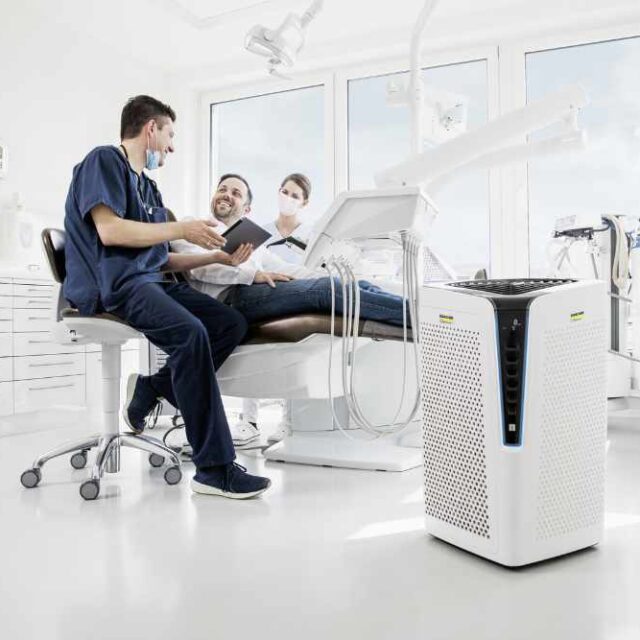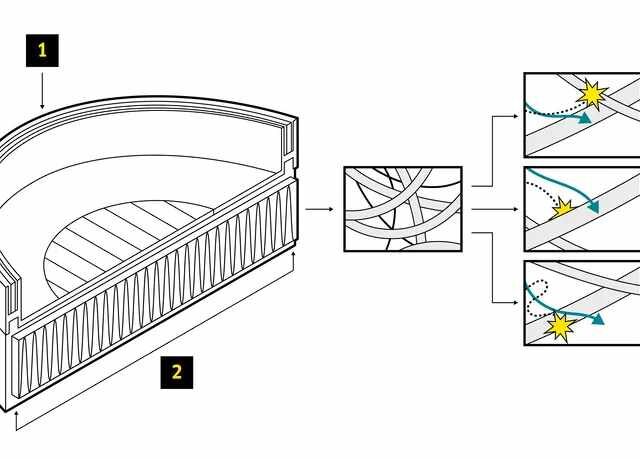Air purifiers: Increase indoor air quality & minimize risks
In times of the corona pandemic, the effectiveness of air purifiers against viruses and infectious aerosol particles is increasingly coming into focus. For above all in closed rooms there is the risk that harmful particles cause illnesses or infections. Thanks to highly efficient filter technology, infectious or hazardous substances in room air are reduced and the aerosol concentration is kept to a low level. Therefore they are suitable for schools and nurseries, offices, hospitality, for care homes and doctors’ practices, as well as for the retail trade.
What air purifiers can do and the important data
Clean and germ-free air is particularly important in the working world, for example in offices, public and medical facilities, hotels and restaurants. In practice, however, it is precisely in these places that poor air often impairs well-being and can lead to health problems.
Some disease-carrying germs, for example the coronavirus, enter room air as a component of larger aerosol particles. In closed rooms there is therefore the risk that people may be indirectly infected, even if social distancing and hygiene rules are followed.
With HEPA filters with a specially high separation degree, air purifier can effectively filter from the air and retain even tiny particles measuring just a few micrometres*.
* Separation degree: H13: 99.95 %; H14: 99.995 % (with a particle size of 0.1 – 0.2 micrometres)
Air purifiers are not a new invention, but have been the subject of significant investment since the outbreak of the coronavirus pandemic.
The background: In closed spaces they are an effective method for reducing the concentration of not only harmful substances, allergens and fine dust, but also pathogens. However, there are various technologies and also in terms of air flow rate, filter and volume many variants are available. Air purifiers always improve the air quality and reduce the infection risk, whether it be in offices, waiting areas, classrooms or in your own home. Contact our air purifier hire team today to find out which air purifier is best for you.
Prefilter, activated carbon, (H)EPA: The right technology
There are various technical options to increase the air quality in closed spaces and remove harmful substances from the air: ozone generators, air purifiers with ionisers or UVC lamps and air purifiers, that are based on ventilation and work with filters.
Air purifiers with ventilation provide an air flow towards the machine. The air is drawn in, guided through filters and ejected again. Harmful, allergenic suspended matter and gases are absorbed, the air quality is improved. At the same time, no harmful substances are produced from the change of air.
Many ventilation devices with filters work with a vacuum and/or washable prefilter, which removes larger particles, animal hair, and co., from the air to protect the sensitive filter for suspended matter. An activated carbon filter can be used downstream, which binds gaseous impurities via the principle of adhesion: One gram of activated carbon has an area of 1000 square metres, as the material is highly porous. Odours, gases and chemicals are trapped and thus effectively withheld.
The key component of an air purifier with ventilation is the filter for suspended matter, generally known as a HEPA filter. They consist of wafer-thin plastic threads, which are interwoven into a fleece, and generate their filter effect via an electrostatic charge. For HEPA filters there are different classifications. It is specified to what extent a filter must withhold particles which can be the most difficult to filter owing to their size. Based on the known filter effects, this critical particle size is between 0.1 and 0.3 µm. For H13 filters it is stated that they remove up to 99.95% of particles in this size from the air, for H14 filters it is 99.995%. Particles which are smaller or bigger are even removed from the air to a higher degree due to various physical effects.
Against the background of the Covid-19 pandemic this information is relevant, as the SARS-CoV-2 virus has a size of approximately 0.1 µm and this lies within the H13/H14 classification. However, viruses are always bound to a host and linked to aerosols, which are significantly bigger than the viruses themselves. This means that machines with an EPA filter of class E11 are already able to eliminate the majority of infectious aerosol particles from the air – because they remove 99.5% suspended matter between 0.1 and 1 µm from the air. Apart from virus-infected aerosols, this also includes other harmful or annoying particles such as pollen, mites, animal hair, household dust, gases and odours or fine dust.
Room size and air flow rate: Which air purifier is suitable for what purpose?
When it comes to choosing a suitable machine, then the size of the room in which the air purifiers should be set up is key. In general, the air in a room should be cleaned three times an hour in order to achieve an effect against allergens such as pollen or mites. If it involves reducing the risk of infection with SARS-CoV-2, based on a highly regarded study conducted by the Bundeswehr University Munich the room volume must be circulated six times an hour.
If a room has an area of 60 square metres and is 3 metres high, then 180 cubic metres of air must be moved at this frequency. In this case if an air purifier of 550 cubic metres per hour is used, then two machines should be installed – ideally on opposite walls. Then two air cylinders are installed in the room, which reliably move the ambient air towards the air purifiers. The appropriate filter class should also be chosen, i.e. at least E11 or ideally H13/H14. Even if air purifiers are used properly in schools, the restaurant trade or offices, regular ventilation is still required in order to ensure the necessary fresh air supply.
Note: Continuous operation is also a crucial aspect for the success in everyday use of air purifiers. In this respect the noise level plays an important role in noise-sensitive areas such as classrooms. Because the necessary acceptance is only established if the operating noise is not deemed to be too disruptive or annoying. As stipulated in the workplace ordinance, the maximum level of 50 dB should not be exceeded, which is slightly higher than the sound of a normal conversation.




















